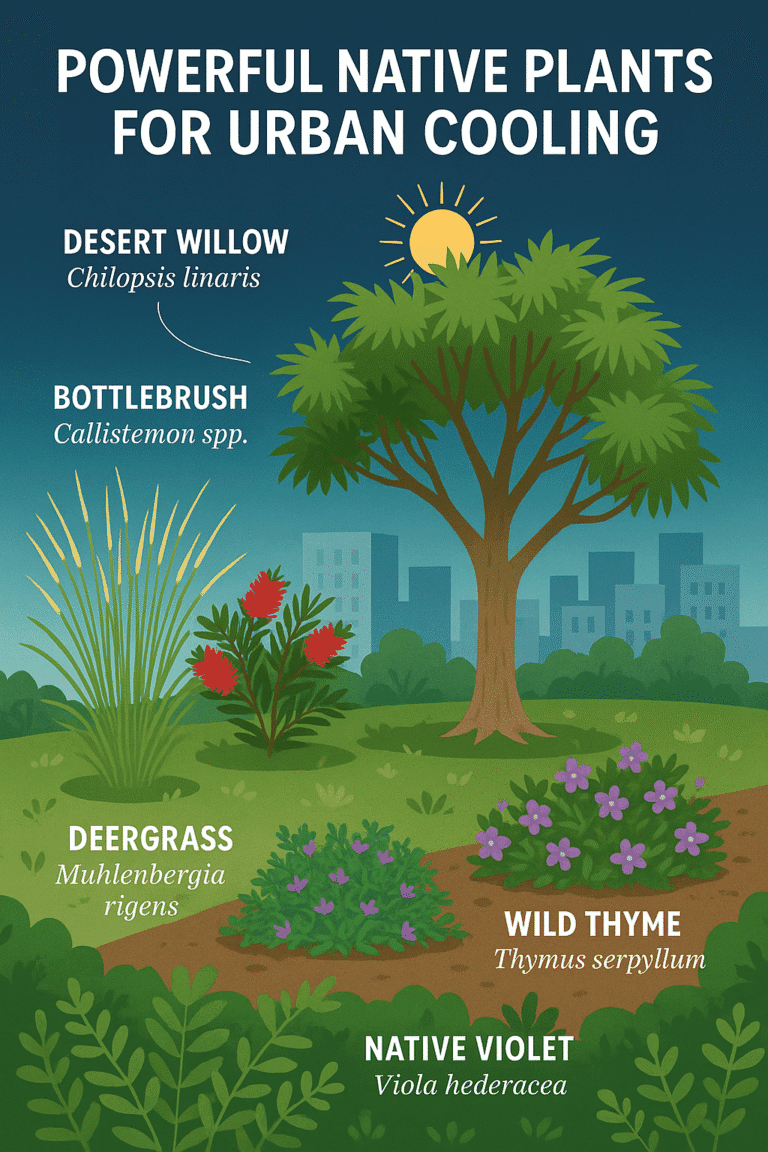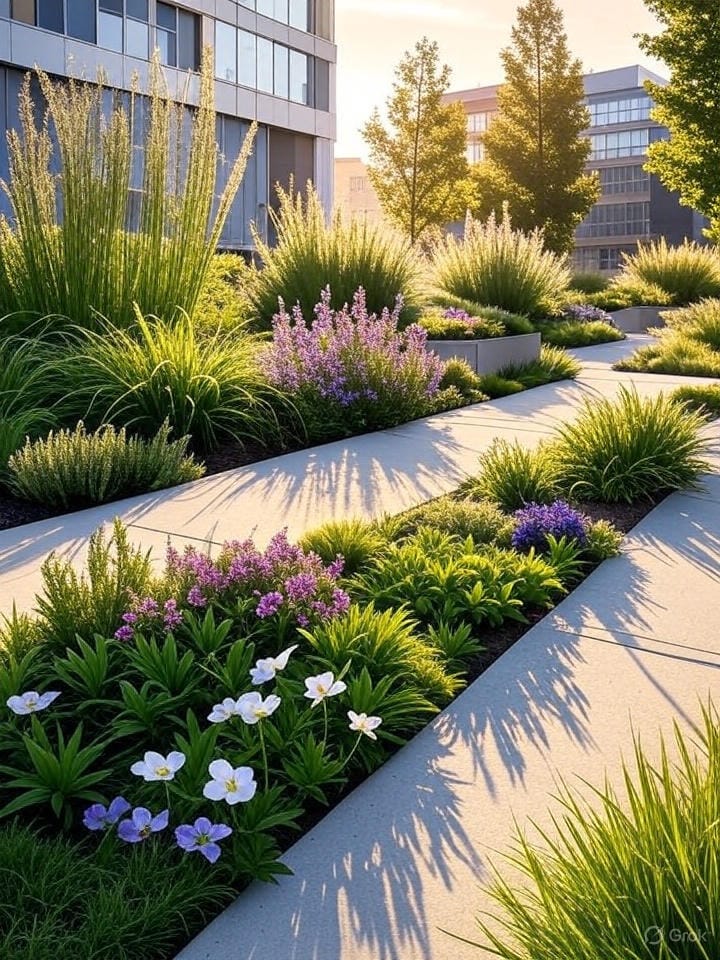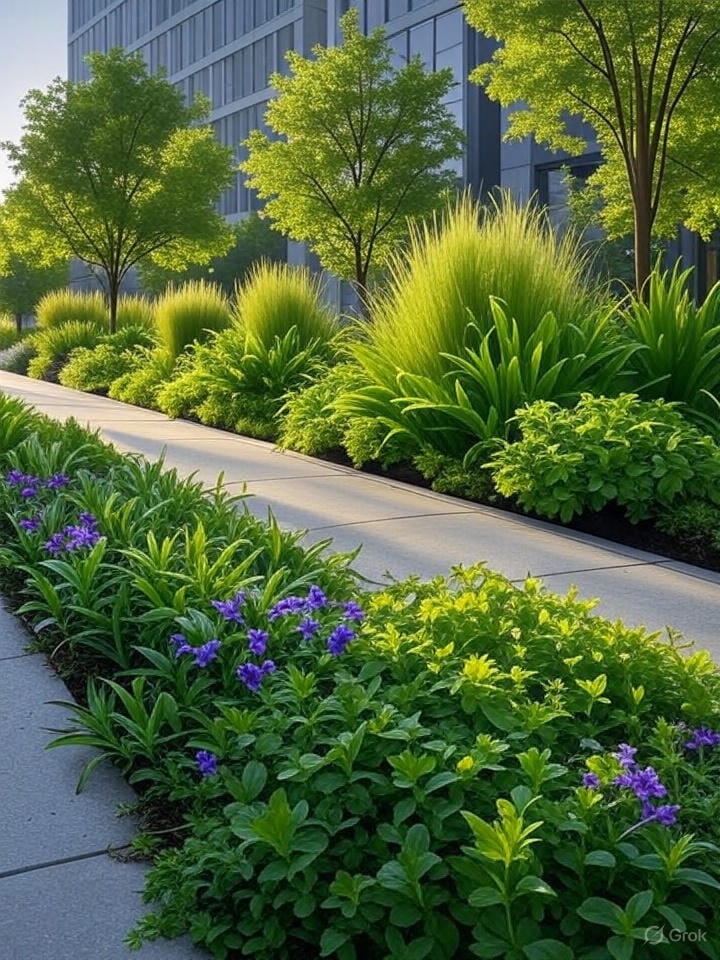
Table of Contents
ToggleWhy native plants for urban cooling are Trending
You have noticed that cities are getting hotter and faster. Urban areas are experiencing the urban heat Island effect due to concrete, glass and Asphalt that trap heat all day and radiate it at night. In some cities this can push temperatures 7°C (13°F) higher than surrounding rural areas. On the other hand, high-tech cooling solutions like reflective rooftops and mist systems exist but the one simple solution: native plants for urban cooling.
They aren’t just any plants. Native urban plants for cooling are those species that are naturally adapted to the region’s climate which means they thrive in tough city conditions without extra water, fertilizer or constant maintenance. Unlike exotic ornamentals, they’ve evolved to survive drought, poor soil and temperature swings. In this blog we will see the benefits, design, maintenance tips best native plants as ground cover.
Best ground cover for heat islands
In concrete-dominated cities, exposed surfaces like Asphalt and bare soil become heat amplifiers. On a Hot summer day, these surfaces can spike up to 60°C (140°F). But there’s a natural fix: native ground cover for heat islands. These plants form a living insulation layer that cools surfaces, protects the soil, and adds biodiversity without artificial turf or excessive water. Why do many Green project fails ?
When you are choosing the best ground cover for heat islands, focus on these types of plants –
- Native (adapted to local heat and drought)
- Low-growing (covering more surface area per plant)
Resilient in compacted or polluted soils
- Visually good-looking with low maintenance requirements
Top Native ground covers that cool urban spaces :-
1. Deergrass (Muhlenbergia rigens) : This bunchgrass is native to North America and thrives in full Sun and poor soil. It’s dense, traps moisture at the soil level and withstands extreme drought. They are often used along sidewalks, traffic medians and building perimeters.
2. Wild Thyme (Thymus serpyllum) : They are ideal for rooftop gardens, patios and curb strips. It forms a tight and aromatic carpet that is heat-tolerant and foot traffic-friendly. Plus it also supports pollinators which is beneficial for urban biodiversity.
3. Bunchberry (Cornus canadensis) : This is a shade-loving and native to the temperate zone ground cover. They are an underrated ground layer for under tree spaces or north facing walls. It cools the soil in high-density residential areas and slows stormwater runoff.
4. Creeping Saltbush (Atriplex semibaccata) : This ground cover is native to Australia yet now used globally And Tolerates saline, dry and compacted urban soils.Its sprawling form protects against surface heat and erosion.
5. Native Violet (Viola hederacea) : They are also common in Australian cities. It’s soft, ground-hugging and ideal for a shaded courtyard or beneath native shrubs.They actively cool the air at ground level and provide visual softness.
6. Sweet Fern (Comptonia peregrina) : Shrub-like ground layer with fragrant leaves, it is highly adaptive to urban soils with deep roots that improve percolation and surface cooling.
Bonus Tip : Combine Layers
Cities that combine ground covers with shrubs and trees report 3–5°C cooler surface temperatures than areas with mulch or bare soil. This layered cooling approach works around – Rooftop edges, Courtyard paving gaps, Park borders and Walkways between buildings. You can also build a green parking lot.

Benefits of drought proof city plants
Unlike exotic landscaping that demands frequent watering, pesticides or expensive upkeep drought-proof native species are built for urban survival. They can evolve to handle dry spells, poor soil and heat which makes them ideal for roadsides, rooftop gardens, medians and even neglected corners.
1. Water saving without Green loss: These plants survive on natural rainfall or minimal supplemental watering which helps cities to meet water conservation goals without turning landscapes brown. Blue roofs benefits – untold mystery
2. Thrives Where other plants fail: whether it’s poor soil along busy roads, compacted ground in schoolyards or full Sun rooftops, drought-tolerant natives keep growing where lawns or ornamentals often die.
3. Lower Maintenance costs for cities: No need for irrigation systems, chemical fertilizers or trimming. Municipalities and property owners save thousands each year by choosing low-input species.
4. Year-round ecological function: even when dormant, these plants stabilize soil, cool surfaces and support urban wildlife like native bees, birds and butterflies.
5. Climate Resilience in a warming world: as heat waves become more intense and unpredictable, drought-proof plants act as living buffers. It helps to regulate temperature and moisture at the ground level.
Cities like Los Angeles, Cape Town and Sydney have already switched to drought proof City plans for over 50% of their public landscaping projects and they are reporting long-term cost and water savings. These aren’t just plants that survive- they are solutions. And in a world where every drop of water is counted, they offer the green without the guilt.

Low Maintenance Urban greenery
In dense cities where landscaping budgets are tight and maintenance crews are stretched thin, the best plants are the ones that take care of themselves. That’s where low-maintenance urban greenery stands out which offers cooling, aesthetic and ecological benefits without needing constant attention.
Native plants shine here again. Since they’re adapted to local soils, rainfall patterns and temperature extremes that’s why they demand far less input than exotic ornamentals. Once they are established they can grow with little to no fertilizer, irrigation or pruning.
Why does Low Maintenance matter in cities ?
- Labor costs are rising especially in large public parks or corporate campuses
- Water use restrictions are increasing globally
- Sustainability mandates require low impact landscape designs
- Green areas must survive neglect in areas like rooftops, schoolyards or medians
Best Types of Low Maintenance Greenery
1. Native grasses and groundcovers-
- Spread quickly and suppress weeds
- No mowing needed
- Examples: Deergrass, Creeping Saltbush, Native Violet
2. Hardy Native Shrubs
- Form natural shapes, eliminating the need for trimming
- Resistant to pests and drought
- Examples: Toyon, Sweet Fern, Bottlebrush
3. Perennial Wildflowers
- Return year after year without replanting
- They support pollinators while reducing bare soil heating
- Examples: Purple Coneflower, Yarrow, Black-Eyed Susan
Where This Works Best
- Rooftop gardens with limited access
- Road medians and footpath edges
- Schools, hospitals, and low-traffic areas
- Corporate zones with minimal maintenance contracts
Cities like Portland, Chicago and Canberra have adopted “low-mow native zones” in parks and medians. It has reduced upkeep costs by over 30%. Low maintenance urban greenery creates cooler and more inviting spaces in any area, whether it’s a public park or an office courtyard.

Design tips: Native landscaping for urban heat
Planting native species is only half the solution — where and how you plant them is what determines their true cooling power. Smart native landscaping for urban heat isn’t just about throwing in a few trees, it’s about combining layers, placements and site-specific choices. A single tree on asphalt may provide minimal relief, but layered native plantings can drop surface temperatures by 5–7°C, enhance airflow, and reduce glare.
Perfect design tips using native plants
Layered planting zones (Tree + shrubs + groundcovers)
- Combines canopy cover, mid-height shading and ground insulation
- Prevents soil baking, slows down runoff, and reduces ambient heat
- Ideal for wide sidewalks, greenways, and institutional campuses
Strategic Placement for Max Cooling
- Place native trees near south/west-facing walls to shade heat-retaining surfaces
- Use native vines (e.g., native honeysuckle) on trellises to shield heat-reflective glass
- Create shaded wind corridors in courtyards or between tall buildings using drought-tolerant shrub belts
Pocket Planting in Hardscapes
- Integrate native greenery in sidewalks, medians, or parking lot islands
- Even small beds with native grasses or low shrubs can reduce thermal radiation
- Works well where full green spaces aren’t possible
Raingarden + Native Integration
- Combine stormwater capture with heat reduction using native wet-tolerant plants
- Native sedges, rushes, and pollinator-friendly perennials thrive in bioswales and retain moisture naturally
- They are Perfect for schools, parks, and civic buildings
One thing you need to know is that native plants with grey green or fuzzy leaves often reflect more sunlight and lose less moisture which makes them ideal for exposed sites like rooftops or sun-facing walls.
FAQs
What are the best native plants for urban cooling in hot cities?
Cities like Phoenix, Delhi and Sydney use native trees like Desert willow and bottlebrush, drought-tolerant shrubs (e.g. Sweet Fern) and low Groundcovers (like – deergrass and wild thyme) to reduce surface heat and reflect sunlight. These plant thrives without irrigation and provide dense shading in urban spaces.
Which ground covers work best to reduce heat in urban areas?
The best ground covers for urban heat islands include native options like creeping Saltbush, Bunchberry and native violet. They act like living insulation – cooling pavement edges, courtyards, rooftops and footpaths while reducing surface temperature up to 5°C.
Are drought proof city plants really low maintenance?
Yes. Most drought-proof city plants, especially native ones, need minimal care once they’re established. They survive on rainfall alone, require no chemical fertilizers, and are naturally resistant to urban pests and pollution. All these abilities make them ideal for streets, rooftops and medians.
